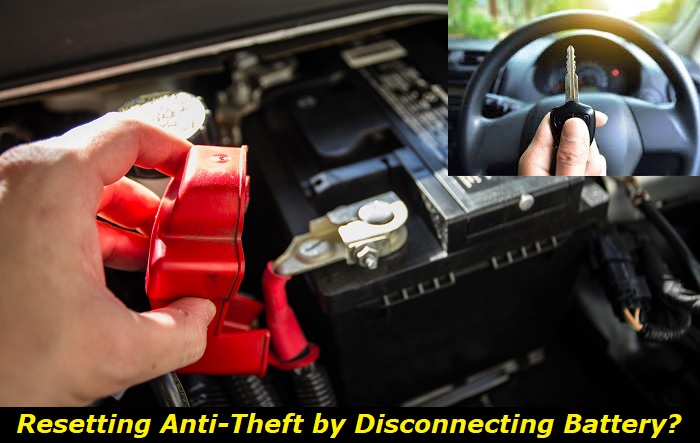If the engine is the heart of the car, then the battery is arguably its soul. A car's battery is critical in all operations, and a malfunction on its part can leave you stranded. The car's battery is mandated with powering the ignition process and other systems or components in the term. The battery also protects the ECU from a power surge.
Electrical equipment problems highlights
- Level of urgency:low
- DIY inspection:possible
- DIY repairs:possible but complicated
- Can you drive?yes
- Price of repairs:$150 - $350
- Ifignored:problems may develop and escalate
- Ways to fix:diagnose and replace the broken parts, try resetting the affected units

Understanding how anti-theft works
The vehicle anti-theft system or a device is installed on your car to prevent its theft or contents inside. The anti-theft system comes with sensors installed in and out of the vehicle. The sensors trigger the alarm system whenever there is an impact, movement, or disturbance in or outside the car.
Nowadays, many cars come with OEM alarm systems, but you can install an aftermarket one if your vehicle doesn't come with one. You will also find manufacturers are now connecting the anti-theft systems with the radio receiver, motion detector, or immobilizer. The remote keyless system is even more robust as it employs authentication mechanisms to secure the vehicle.
The car battery powers all anti-theft systems. The anti-theft system will fail whenever the battery is faulty or dead, which could mean another person can unlock your vehicle and drive off. Even for the most advanced anti-theft systems where the engine immobilizers connected to the ignition system are used, the battery plays a critical role.
You should have an easy time knowing when the anti-theft of your car is armed or not. When the anti-theft light is flashing, and the engine won't start, you have an anti-theft issue in your hands. This means that the anti-theft module is faulty or the system can't recognize the keyless entry signal. It could even be a problem with the wiring system.
How does disconnecting the battery reset the anti-theft system?
Disconnecting the battery or replacing a dead one with a new one can cause a lot of issues. In most cases, however, replacing the battery or disconnecting the terminals should not cause any problems. Many modern vehicles have their anti-theft system connected to the engine control unit (ECU). When you disconnect the battery, the anti-theft system is reset.
Even though you can unlock the doors, the engine won't start after disconnecting the battery. This is because the anti-theft thinks someone wants to steal the vehicle. When you try to start the car, there will be a crank, but the engine won't start. You will need to disconnect the terminals for about two minutes to solve this.
Disconnecting the battery's positive terminal for about two minutes helps reset the anti-theft system. The ECU will not have a problem once you try to start the engine again. Mind you, this is to reset the anti-theft and not the ECU.
In some vehicles, the engine won't start or will die almost immediately after starting. Leave the key in the start engine position for about 10 minutes. The security light stays on for about 10 minutes, and when it goes off, wait for another 20 seconds before starting the engine.
The anti-theft system is sensitive, and car makers are adding more security features by the day to keep yourself and your car safe. Disconnecting the battery affects some systems and car parts, which need to reset for you to continue enjoying driving as before. Some systems will reset themselves automatically, but others require your input. Below are the other systems that reset when you disconnect the battery.
What else resets when you disconnect the battery?
1) Disruption of the vehicle's computer
The electronic systems of your car are centrally controlled via the computer. When the battery is disconnected, power to the computer is disrupted, which means functions that require the vehicle to keep memory off are scrambled. You will find favorite preset radio stations are lost, and you will need to reset them afresh. Depending on your car's make and model, relearning previously set settings may take up to 72 hours.
The driver seat settings will also be disrupted after a battery disconnection. But a reset should be easy. In Lexus RX 300, for example, all you have to do is sit in the driver's seat and close the door.
- Set the seat to the desired position.
- Turn the ignition to ON.
- Do not start the engine.
- Hold the 'set' button until you hear a beep sound.
2) The Powertrain control module (PCM)
The PCM is more like the brain of the car. The PCM manages the transmission, the engine, and other car systems. It receives information from many sensors and adjusts various aspects of the vehicle, making it run smoothly.
When the battery is disconnected, you may notice the engine starts running poorly. The PCM uses sensors to regulate the air/fuel ratio in the combustion chambers. The battery disruption causes the ratio to go off, and this causes the engine to run poorly. You may notice a sluggish acceleration of jerky disruptions as you drive. You don't need to do anything; the PCM relearns these trim adjustments, and the engine will run smoothly before long.
The ABS, also controlled by PCM, gets disrupted when you disconnect the car battery. If the ABS keeps popping up, you can make it disappear by disconnecting the battery. The ABS light will disappear once you reconnect the terminals. The only issue is that the ABS is tested after every engine start-up. Therefore, the ABS light will come on every time you start the engine.
3) The engine control module (ECM)
Some warning lights, such as the CEL (check engine light), can be made to go away when you disconnect the battery. Disconnecting the battery and draining the retention power in the ECM will reset the module. When all power is drained from the ECM, error codes will be erased automatically when you start the engine. If the error code is erroneous, the warning light originating from this code will disappear from the instrument cluster. This trick can be used to address engine misfires and diagnose ECM malfunctions too.
Disconnecting the battery for ECM resetting is more like the hard rebooting of a PC. The procedure requires you to disconnect the battery terminals for one hour. Here is how to reset the ECM;
- Disconnect the negative cable of the battery.
- Pick a jumper cable and connect a clamp to the disconnected negative cable. The other jumper cable clamp is connected to the positive terminal to complete the circuit. Wait for at least 15 minutes.
- Once the 15 minutes are over, detach the jumper cable from the battery. Reconnect the negative cable to the battery and secure it properly.
- Put the key in the ignition and turn it to the ON position. For cars with a fob key, press the start button twice, and you shouldn't step on the brake pedal while doing this. The instrument cluster will come alive with warning lights when you do this. The CEL, however, will not pop up.
- Turn the key to the OFF position and then start the engine. For those with remote fob keys, press the start button once, and the car will be in the OFF state. Depress the brake pedal and push the start button. Let the engine idle for 15 minutes. This is the time the reset of the ECM is happening. The ECM will recalibrate as required by driving for a few hundred miles.
How to safely disconnect the battery
Disconnecting the car battery is straightforward. But if done wrong, things can go south very fast. You should be aware that handling the battery wrong could even cause a fire which can cost you greatly. Here are the simple steps to follow when disconnecting the battery;
- Turn the ignition to the OFF position and remove the key.
- Find the negative terminal and loosen the nut securing the cable to the terminal. The negative terminal has a (-) sign on it. Remove the cable and ensure it doesn't touch the body's frame.
- Remove the positive (+) cable and also ensure the cable doesn't come into contact with anything metallic.
- If you want to remove the battery, unscrew the clamps holding the battery in place and lift the battery. Beware, the battery weighs at least 30 pounds.
Conclusion
The battery plays a critical role in the efficient operation of the vehicle. Any power disruption when the car is turned off will cause all the systems to go off. Vehicles older than 2005 have basic ECUs and PCMs, and disconnecting the battery will reset most of the systems.
For the newer models, the systems are more advanced, and disconnecting the battery will only disrupt a number of systems. It is, therefore, essential to know what will happen to your car before disconnecting those battery cables.
About the authors
The CarAraC research team is composed of seasoned auto mechanics and automotive industry professionals, including individuals with advanced degrees and certifications in their field. Our team members boast prestigious credentials, reflecting their extensive knowledge and skills. These qualifications include: IMI: Institute of the Motor Industry, ASE-Certified Master Automobile Technicians; Coventry University, Graduate of MA in Automotive Journalism; Politecnico di Torino, Italy, MS Automotive Engineering; Ss. Cyril and Methodius University in Skopje, Mechanical University in Skopje; TOC Automotive College; DHA Suffa University, Department of Mechanical Engineering






Add comment